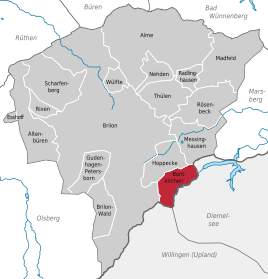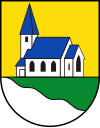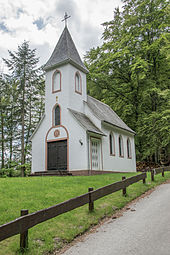Bontkirchen
|
Bontkirchen
City of Brilon
|
|
|---|---|
| Coordinates: 51 ° 21 ′ 20 ″ N , 8 ° 39 ′ 29 ″ E | |
| Height : | 407 (384-689) m above sea level NHN |
| Area : | 5.44 km² |
| Residents : | 517 (Dec. 31, 2013) |
| Population density : | 95 inhabitants / km² |
| Incorporation : | 1st January 1975 |
| Postal code : | 59929 |
| Area code : | 02963 |
|
Location of the village of Bontkirchen within the urban area of Brilon
|
|
|
Aerial photo (2013)
|
|
Bontkirchen is a village in the eastern Sauerland . The municipality, which was independent until the end of 1974, is now a district of the city of Brilon in the Hochsauerlandkreis , North Rhine-Westphalia . The Upland and the adjacent Waldeck are also partly in the area of the municipality of the village.
geography
Bontkirchen, located in the valley of the Itter , lies directly on the border with Hesse , which in this area ran along the Itter. To the east of the border is the village of Stormbruch , which belongs to the Diemelsee community, and Willingen to the south . The mountains Großer Buttenberg 627.4 m and Örenstein 641 m , belonging to the northeastern foothills of the Rothaargebirge, separate Bontkirchen from Hoppecke in the north. In the west is the Hemberg 688.5 m and beyond the Brilon mountains in the valley of the Hoppecke Brilon forest .
The Itter is the largest river in the district. It flows through the village in a predominantly northeastern direction. She leaves the district at an altitude of 384 m above sea level. NHN and flows into the Diemelsee a little later . Due to the former border course along the Itter, part of the village was on Hessian territory in the Stormbruch district of the Diemelsee community for a long time.
history
Several variants are known for the origin of the place name Bontkirchen. Originally the name consists of a combination of “-kirche” and “Bȭbo”, which refers to the variants “mnd. bȭve 'spitzbube', mhd. buobe 'Knabe', nhd. Bube “. In the literature the interpretation is given: 'at the Kiche des Bȭbo'.
The village was first mentioned in a document in 1276 as Bobbenkercken (also: Bowenkerken, Bunkerken, Buntkerken, Bundtkerken Buntkirchen, Bunnkirchen, Bonnkirchen ). Bontkirchen has an eventful history, which is based on the border location of the village between secular and ecclesiastical border areas of the village. There are problems between the Archdiocese of Paderborn and the Archdiocese of Cologne and the secular lords, the County of Waldeck , the lords of Padberg , the city of Brilon and, most recently, between the federal states of Hesse and North Rhine-Westphalia .
Simon I von Lippe , as Archbishop of Paderborn, initiated the revival of the parish in Bontkirchen in 1276 and appointed St. Vitus as the patron of the foundation. In 1335 Johan van deme Scharpenberge renounced his fiefdom at Buwenkerken before Count Heinrich IV. Von Waldeck . In the period that followed, the Bredelar monastery gradually acquired the village. The monks of the monastery acquired the Bontkirchen property from the Lords of Scharfenberg in 1347 and 1366. In 1373, the Lords of Padberg gave the monastery their rights with church fiefs , tithes , services and the castle court. On April 1, 1376, Heydenrich and Steven von dem Scharpenberge donated, among other things, all of their feces , that is, farmhouses, in Bontkirchen to the Bredelar monastery. After a long period of desertification , colonization began again in 1497.
The border with Waldeck repeatedly led to disputes and incidents. It is reported that "a Cort Molner from Buntkercken was imprisoned in Brilon in 1540 because he had been drunk and claimed that the Bontkirchener Hüttenhammer was the property of the Count von Waldeck". In 1507 the Lords of Padberg finally renounced their rights in Bontkirchen after tensions on May 4, 1507. The monks of Bredelar finally became rulers of the village when the tithe was obtained from the Lords of Horhusen in 1521/27. The Thirty Years' War also had an impact on the population. However, the Bontkirchener Hütte survived the war. At the instigation of Ferdinand von Bayern , church “ visitations ” were carried out from 1612 to 1626 . For “Bonnkirchen” the following was recorded: “Now border villages were found that adhered to neighboring Protestant parishes. So the village of Bonnkirchen had become a branch of the Waldeck church village of Heringhausen ; But now the Bredelar monastery was able to perform the service in Bonnkirchen and the long suppressed parish there was brought back to life. ”The Brilon judge Jacob Kannegießer reported on May 15, 1652 that Bontkirchen had 3 tension yards and 9 kötter at that time there were 7½ tension yards and 15 kötter.
During the reign of Clemens August von Bayern in 1732 the diocesan borders were changed. As a result, Bontkirchen fell outside the sphere of activity of the Diocese of Paderborn and was assigned to the Diocese of Cologne . During Napoleon's time , Bontkirchen came to the Landgraviate of Hessen-Darmstadt in 1802 . After the Congress of Vienna in 1816, the Duchy of Westphalia and with it Bontkirchen came to Prussia .
There was a fatal incident in 1819. After October 25, two Aschhütten had been torn down by a princely waldeck MOORISH military command, four days later of the cases of carbon wood shot employed Christoph Koechling by a rule waldeck soldiers. In 1830, the borders were precisely measured to end the old border disputes. In 1844 the village was assigned to the Thülen office. In 1864 there are 498 residents registered in the village.
On March 29, 1945, unarmed German soldiers reached Bontkirchen from the Brilon Forest all day and the following night. There they had been shot at by US troops traveling through Brilon Forest on their transport train and fled. Before moving on, the soldiers dressed in a clothing store of the Todt Organization , which was located in the rifle hall. The remaining items of clothing were taken to various houses for safekeeping and were later supposedly handed in properly. On April 3, US troops appeared for the first time to take the approximately 50 Wehrmacht soldiers in the village to a prisoner collection point in Bredelar. On April 4, four smaller US units reached the village; one of these units stayed in the village overnight and moved on in the morning.
During the Second World War , 28 Bontkirchen soldiers died as soldiers, most of them on the Eastern Front , or died in captivity.
Since the end of the 1950s, the city of Brilon has been striving to change the border to the Stormbruch district , from January 1, 1972 a district of the Diemelsee municipality . There were seven residential buildings with 22 residents, a former carpenter's workshop, the shooting hall and the lawn sports field on Willinger Strasse. As a result of the regional reform in North Rhine-Westphalia , Bontkirchen became a district of Brilon on January 1, 1975. In 2009, a state treaty between Hesse and North Rhine-Westphalia was concluded for the surrender of 55 parcels with a total area of 14 hectares . Brilon paid Diemelsee an amount of 390,000 euros to compensate for the loss of territorial and tax power. On November 1, 2009, the State Treaty came into force. The previously Hessian part of Willinger Strasse has officially been part of North Rhine-Westphalia since then. The residents had campaigned for this solution for decades.
politics
Community leader
- 1803–1817 W. Birkenhauer (mayor)
- 1823–1857 Caspar Schulte
- 1858–1864 Josef Lange
- 1864–1877 Friedrich Hennecke
- 1877–1883 Wilhelm Lange
- 1883–1895 Wilhelm Schilling
- 1895–1901 Wilhelm Hennecke
- 1901–1922 Josef Pack
- 1922–1925 Franz Schulte
- Wilhelm Heckmann
- Johann Bunse
- (1946) –1952 Wilhelm Heckmann
- 1952–1958 Lorenz Metten
- 1958–1969 Wilhelm Schilling
- 1969–1974 Franz Hahn
- 1974–2009 Albert Brüne
- Since 2009: Dieter Marczyk
coat of arms
Blazon
In gold, a natural-colored, blue-roofed church over a shield base divided diagonally from silver to green in a wavy cut.
Description
The coat of arms of the municipality of Bontkirchen, approved on December 1, 1954, shows the eponymous village church as the main motif. The base of the shield, divided by a wavy line, points to the Itter , which forms the border with Waldeck here. The colors of the Redenden Wappen are freely chosen.
Culture and sights
Buildings
- St. Vitus Church
- Marienkapelle am Hemberg
- Schützenhalle of the St. Vitus Schützenbruderschaft Bontkirchen 1883 e. V.
Regular events
- The Schützenbruderschaft St. Vitus 1883 e. V. Bontkirchen celebrates its rifle festival every year over Corpus Christi.
- The Bontkirchen Ski Club celebrates its sports festival every year in July.
- The Bontkirchen Musikverein celebrates its "Quarry Festival" every year in August
- The men's choir "Cäcilia" Bontkirchen celebrates its May festival every year on May 1st
- The Bontkirchen Volunteer Fire Brigade celebrates its autumn festival every two years
traffic
Bontkirchen is on the L 800 (North Rhine-Westphalia, in Hesse L 3393), which comes from Willingen and leads to the Diemelsee . The K 61 connects the village with Hoppecke.
Local public transport is handled by bus routes in the direction of Brilon and Marsberg . The nearest train station is in Willingen, about eight kilometers away, on the Wabern – Brilon Wald railway line .
literature
- Hugo Cramer: The district of Brilon in the Second World War 1939-1945 - reports from many employees from all over the district. Josefs-Druckerei, Bigge 1955.
- Michael Flöer: The place names of the Hochsauerlandkreis , published in the Westphalian Place Name Book (WOB) , Volume 6, by Kirstin Casemir, Jürgen Udolph, Publishing House for Regional History, Bielefeld, 2013, 608 pages. (online PDF 1.8 MB) ( Memento from May 4, 2019 in the Internet Archive )
- Heinrich Kampschulte, History of the introduction of Protestantism , Verlag F. Schöningh, Paderborn, 1866, page 379
- Association for the history and archeology of Westphalia, Westphalian magazine , since 1837
Web links
- Information from the city of Brilon
- Bontkirchen in the Westphalia Culture Atlas
Individual evidence
- ↑ Michael Flöer: The place names of the Hochsauerlandkreis , pages 71 to 73 (accessed on May 4, 2019).
- ^ Karl Wilhelm Grote, Historisch-Geographisch-statististik-literarisches Jahrbuch , 1817, ( limited preview in the Google book search)
- ↑ 750 years city of Brilon , Ed. City of Brilon 1970, p. 40
- ^ Heinrich Kampschulte: History of the introduction of Protestantism , page 379 ( limited preview in the Google book search)
- ↑ Michael Schmitt, The Cologne Elector Clemens August von Bayern (1700–1761) and the Duchy of Westphalia, in Säuerlander Heimatbund , Edition 2/2000, p. 62 ( available online ( Memento from January 22, 2016 in the Internet Archive ); PDF; 7.7 MB)
- ^ Wilhelm Hoffmann: Encyclopedia of Earth, Ethnology and State Studies, 1864, page 355
- ^ Hugo Cramer: The district of Brilon in the Second World War 1939-1945 . 1955, section Bontkirchen, pp. 72-73.
- ^ Hugo Cramer: The district of Brilon in the Second World War 1939-1945 . 1955, honor roll section Bontkirchen, p. 239.
- ^ Federal Statistical Office (ed.): Historical municipality directory for the Federal Republic of Germany. Name, border and key number changes in municipalities, counties and administrative districts from May 27, 1970 to December 31, 1982 . W. Kohlhammer, Stuttgart / Mainz 1983, ISBN 3-17-003263-1 , p. 332 .
- ↑ 22 new citizens and 14 hectares for NRW - Straße changes the state to n-tv.de from October 31, 2009
- ↑ Stefan Rebein: 22 Hessen are finally allowed to become citizens of NRW. State contract. In: derwesten.de. September 9, 2009, accessed August 20, 2012 .
- ^ Eduard Belke, Alfred Bruns, Helmut Müller: Communal coats of arms of the Duchy of Westphalia, Kurkölnisches Sauerland. Strobel, Arnsberg 1986, ISBN 3-87793-017-4






